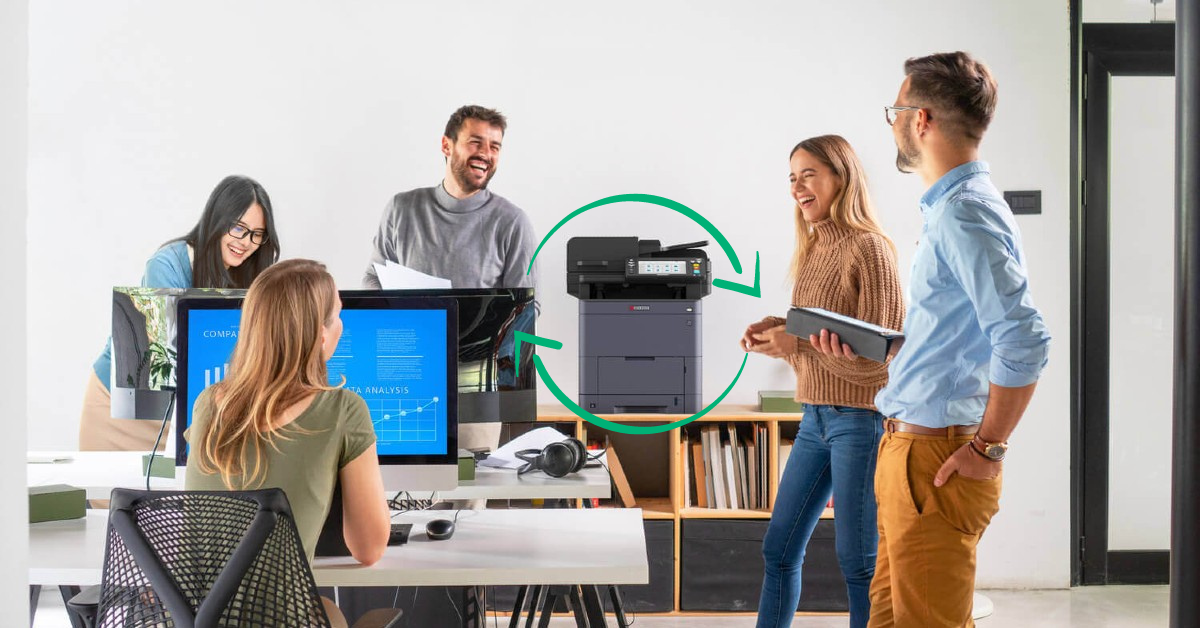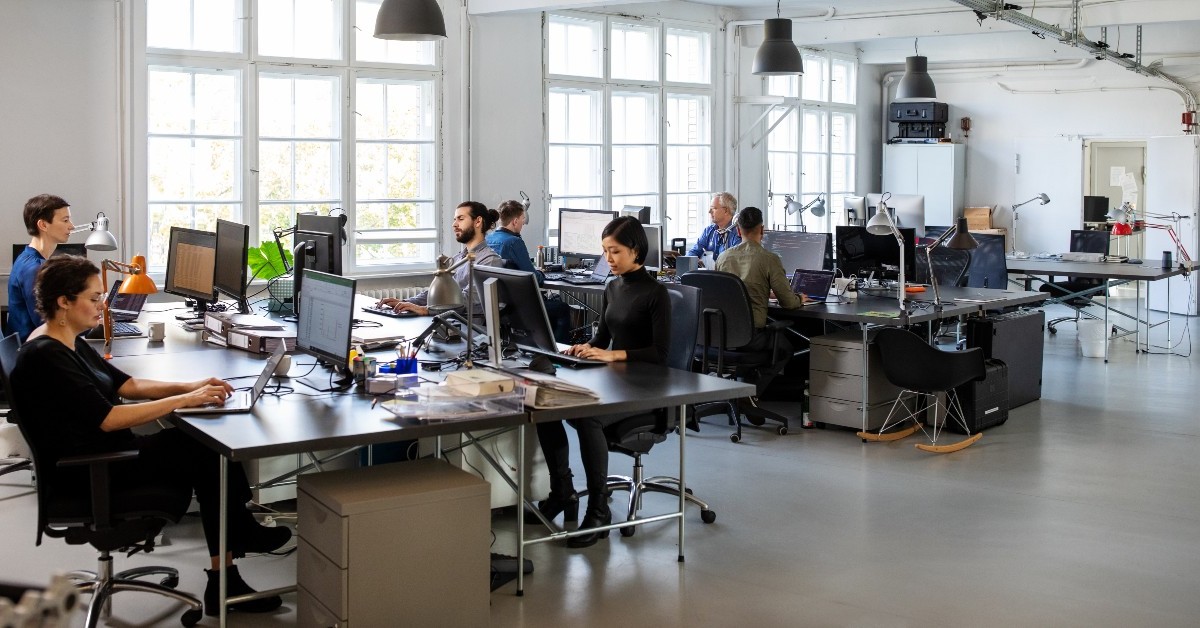Investing in an environmentally friendly printer is a key step your organisation can take towards more sustainable business operations, particularly if you work in an industry that still relies heavily on paper documents. Eco-friendly office equipment, such as printers, not only improve your environmental impact but also offer other commercial benefits, such as reduced operating costs, improved reputation and making your business more attractive to new talent.
However, it’s important to consider the impact of your device throughout its entire lifecycle, not just while you own it. Below you’ll find all the questions and factors you need to take into account for each lifecycle stage when choosing an environmentally friendly printer for your workplace.
How is your printer made and delivered?
Lowering the environmental impact of your printer should start at the very beginning of its life. This means choosing a provider that manufactures their products in a sustainable way, demonstrating a commitment to conserving resources. For example, using less water in their factories, utilising solar energy, or offsetting carbon emissions.
You should also consider the design of your printer and the materials it is constructed from. Look for printers that are made from recycled, non-toxic products and have long-lasting consumable components so as to conserve resources. For example, Kyocera's long-life components, such as our ceramic core drum technology, provide up to double the lifetime of competing products and therefore dramatically reduce service intervals and resource wastage as components need to be updated less often.
Lastly, you should also investigate how your printer will be delivered. Does your provider offset carbon emissions associated with transporting your device? Is the printer packaging made from recyclable materials? Even if these sound like small things, every step you can take to reduce your environmental impact can have a long-lasting effect.
What’s the environmental impact of your printing device while in use?
Consumables and waste
Print consumables can quickly add up to become a significant environmental concern throughout the life of your printer. Not only do they produce more waste but they can also be costly and replacing them can be time-consuming and reduce efficiency. Thankfully, environmentally friendly printers offer better alternatives.
For example, in some printers, when the toner runs out, the entire cartridge (toner and drum) needs to be replaced. By using a printer with a separate drum and toner as in Kyocera’s ECOSYS printer, you will only need to replace the toner, while the drum can continue working, delivering up to 600,000 prints before needing to be replaced. This reduces operating costs and the waste you’re contributing to landfill.
Some providers also offer their customers a cartridge collection service to divert toners from going to landfill. In Australia, Kyocera has partnered with Planet Ark for the Cartridges 4 Planet Ark program that allows you to return cartridges to be repurposed or recycled, while in New Zealand, we offer our Kyocera Collect program to customers.
Energy consumption
Environmentally friendly printers should also have lower energy consumption rates, which is usually demonstrated by compliance with Energy Star Ratings. Factors such as standby and sleep modes will affect overall energy efficiency, as well as power consumption when actually printing, copying or scanning. As an added bonus, energy-efficient printers are also typically more cost-effective, allowing you to minimise your environmental impact and your bottom line.
In-house vs MPS
Finally, it’s worth considering whether a Managed Print Service (MPS) would be more sustainable than managing your print network in-house. MPS providers optimise and control all aspects of your print management, including devices, consumables and software. This provides you with a complete view of your print network, ensuring ongoing enhancements can be made to improve sustainability.
Conversely, most organisations don’t have the same view or control over their in-house solutions, lacking the resources to access, gather and analyse the print data. This means that it’s much harder to identify strategies that could lower the environmental impact of your printing operations - or even what the current impact is.
As part of establishing an MPS, organisations are also encouraged to create printing policies that enable more sustainable practices. You can support less colour printing to reduce cartridge usage, or set company-wide printing guidelines like duplex printing, which reduces paper usage, or greyscale printing, which reduces cartridge usage.
What happens to your printer at the end of its life?
Some printers are made from materials that can be recycled or repurposed and it’s important not to overlook this. Environmentally conscious waste management of workplace products and devices could include the reuse, recycling and disposal of printing devices and toners.
Depending on your location, you can recycle e-waste, which includes printing devices, at drop-off points that are usually stipulated by local councils or your device vendor. Kyocera also provides Australian customers with a certified environmental program that allows you to recycle e-waste, including our multifunction printers and devices, through Ecycle Solutions. Through this collection service, we are able to recycle more than 90% of e-waste material, otherwise destined for landfill.
How Kyocera prioritises sustainability at every stage
One of Kyocera’s main objectives is to create and develop products that are kind to the environment. As a result of our work in this area, we’ve held the ISO 14001 environment certification for over 20 years.
We use recycled materials in our manufacturing process, conduct water purification in our factories and use energy generated from rooftop solar panels. Recycled plastics make up many of the components in our printers, including the outer casings.
Our printers are also designed to meet the Energy Star 3.0 standard to ensure cost savings and enable offices to operate more sustainably by lowering their energy consumption.
All the packaging for our printing devices is completely recyclable and we have won the Australian Packaging Covenant award for sustainable packaging in the Electronics sector in 2018, 2020 and 2021.
The design of our eco-friendly printers is based on sustainable standards every step of the way, from early product development to end-of-life disposal. We even consider the ease of disassembling the product and sorting the materials for recycling at the end of the device’s life as part of our uncompromising commitment towards reducing our environmental impact and supporting our customers to do the same.
By buying from a provider that actively employs thoughtful sustainability measures to create environmentally friendly printers throughout their entire lifecycle, you can set your business on the path towards a greener future.
Sustainability will be an important measure of success for workplaces of the future. Download our Green Office Guide to learn how to improve your environmental impact, while also reducing business costs and boosting efficiency.









